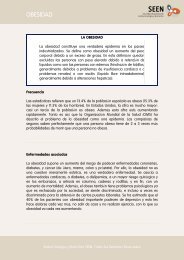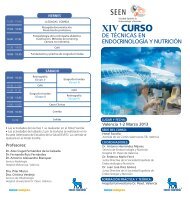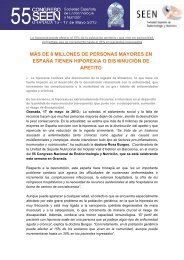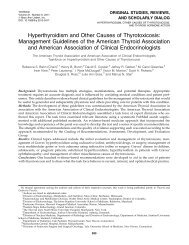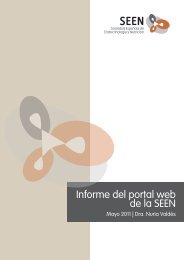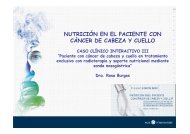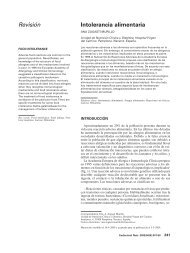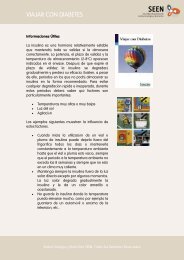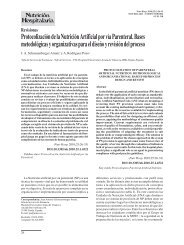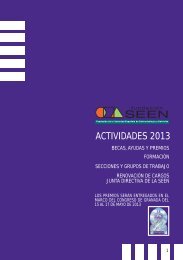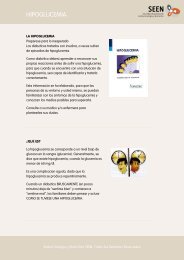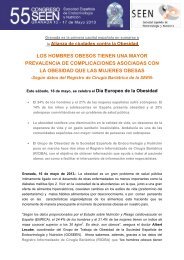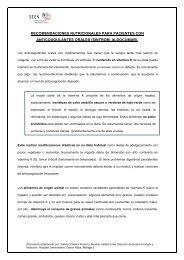Nutrition Support in Adult Acute and Chronic Renal Failure
Nutrition Support in Adult Acute and Chronic Renal Failure
Nutrition Support in Adult Acute and Chronic Renal Failure
You also want an ePaper? Increase the reach of your titles
YUMPU automatically turns print PDFs into web optimized ePapers that Google loves.
Journal of Parenteral <strong>and</strong> Enteral<br />
<strong>Nutrition</strong><br />
http://pen.sagepub.com/<br />
A.S.P.E.N. Cl<strong>in</strong>ical Guidel<strong>in</strong>es : <strong>Nutrition</strong> <strong>Support</strong> <strong>in</strong> <strong>Adult</strong> <strong>Acute</strong> <strong>and</strong> <strong>Chronic</strong> <strong>Renal</strong> <strong>Failure</strong><br />
Rex O. Brown, Charlene Compher <strong>and</strong> American Society for Parenteral <strong>and</strong> Enteral <strong>Nutrition</strong> (A.S.P.E.N.) Board of<br />
Directors<br />
JPEN J Parenter Enteral Nutr 2010 34: 366<br />
DOI: 10.1177/0148607110374577<br />
The onl<strong>in</strong>e version of this article can be found at:<br />
http://pen.sagepub.com/content/34/4/366<br />
Published by:<br />
http://www.sagepublications.com<br />
On behalf of:<br />
The American Society for Parenteral & Enteral <strong>Nutrition</strong><br />
Additional services <strong>and</strong> <strong>in</strong>formation for Journal of Parenteral <strong>and</strong> Enteral <strong>Nutrition</strong> can be found at:<br />
Email Alerts: http://pen.sagepub.com/cgi/alerts<br />
Subscriptions: http://pen.sagepub.com/subscriptions<br />
Repr<strong>in</strong>ts: http://www.sagepub.com/journalsRepr<strong>in</strong>ts.nav<br />
Permissions: http://www.sagepub.com/journalsPermissions.nav<br />
Downloaded from pen.sagepub.com by guest on July 23, 2010
A.S.P.E.N. Cl<strong>in</strong>ical Guidel<strong>in</strong>es:<br />
<strong>Nutrition</strong> <strong>Support</strong> <strong>in</strong> <strong>Adult</strong> <strong>Acute</strong> <strong>and</strong><br />
<strong>Chronic</strong> <strong>Renal</strong> <strong>Failure</strong><br />
Journal of Parenteral <strong>and</strong><br />
Enteral <strong>Nutrition</strong><br />
Volume 34 Number 4<br />
July 2010 366-377<br />
© 2010 American Society for<br />
Parenteral <strong>and</strong> Enteral <strong>Nutrition</strong><br />
10.1177/0148607110374577<br />
http://jpen.sagepub.com<br />
hosted at<br />
http://onl<strong>in</strong>e.sagepub.com<br />
Rex O. Brown, PharmD, FCCP, BCNSP 1 ; Charlene Compher, PhD, RD, FADA,<br />
CNSC 2 ; <strong>and</strong> the American Society for Parenteral <strong>and</strong> Enteral <strong>Nutrition</strong><br />
(A.S.P.E.N.) Board of Directors<br />
F<strong>in</strong>ancial Disclosure: none declared.<br />
Background<br />
<strong>Renal</strong> failure results when the kidneys cannot adequately<br />
excrete nitrogenous <strong>and</strong> metabolic wastes, either acutely,<br />
as a part of a cl<strong>in</strong>ical illness, or chronically over years of<br />
decl<strong>in</strong><strong>in</strong>g renal function. The spectrum of symptoms <strong>and</strong><br />
outcomes <strong>in</strong> acute renal <strong>in</strong>jury are highly variable rang<strong>in</strong>g<br />
from anuria to adequate ur<strong>in</strong>e output, <strong>and</strong> from a short<br />
period of reduced glomerular filtration to the need for<br />
prolonged renal replacement therapy. To reflect this diversity<br />
of cl<strong>in</strong>ical presentation, the <strong>Acute</strong> Dialysis Quality<br />
Initiative Group recommended a change <strong>in</strong> term<strong>in</strong>ology<br />
from acute renal failure to acute kidney <strong>in</strong>jury (AKI). 1<br />
The major causes of AKI <strong>in</strong>clude sepsis, trauma, hypotension,<br />
<strong>in</strong>travenous contrast dye, medications, <strong>and</strong> preexist<strong>in</strong>g<br />
chronic kidney disease (CKD). Despite<br />
improvements <strong>in</strong> dialysis therapy <strong>and</strong> the delivery of<br />
nutrition support, the mortality of AKI cont<strong>in</strong>ues <strong>in</strong> the<br />
range of 50%–60%. 1–4<br />
The evidence-based National Kidney Foundation<br />
Kidney Disease Outcomes Quality Initiative (K-DOQI)<br />
guidel<strong>in</strong>es classify CKD <strong>in</strong>to 5 categories (I-V) based on<br />
measured glomerular filtration rate (GFR; Table 1). 5 The<br />
most common causes of CKD <strong>in</strong>clude diabetes mellitus,<br />
hypertension, <strong>and</strong> glomerular disease. Despite advances<br />
<strong>in</strong> dialysis <strong>and</strong> transplantation, the prognosis of CKD<br />
rema<strong>in</strong>s bleak. Accord<strong>in</strong>g to the United States <strong>Renal</strong> Data<br />
System, the annual mortality for chronic dialysis patients<br />
From the 1 Department of Cl<strong>in</strong>ical Pharmacy University of<br />
Tennessee Health Science Center, Memphis, TN; <strong>and</strong> 2 University<br />
of Pennsylvania School of Nurs<strong>in</strong>g, Philadelphia, PA.<br />
Address correspondence to: Charlene Compher, PhD, RD,<br />
FADA, CNSD, Editor <strong>in</strong> Chief, A.S.P.E.N. Cl<strong>in</strong>ical Guidel<strong>in</strong>es<br />
Editorial Board <strong>and</strong> Associate Professor of <strong>Nutrition</strong> Science,<br />
University of Pennsylvania School of Nurs<strong>in</strong>g;<br />
e-mail: compherc@nurs<strong>in</strong>g.upenn.edu.<br />
exceeds 20%, <strong>and</strong> life expectancy of dialysis patients is<br />
3–11 years shorter than the age-matched general population<br />
(range depend<strong>in</strong>g on age). 6<br />
The purpose of these Cl<strong>in</strong>ical Guidel<strong>in</strong>es is to evaluate<br />
the evidence underly<strong>in</strong>g the provision of nutrition<br />
support to patients with AKI <strong>and</strong> CKD. <strong>Chronic</strong> nutrition<br />
care of these patients beyond the provision of enteral<br />
nutrition (EN) or parenteral nutrition (PN) is not<br />
addressed by these Guidel<strong>in</strong>es. The data tables focus on<br />
citations s<strong>in</strong>ce 2000, to cover the period s<strong>in</strong>ce the previous<br />
2002 A.S.P.E.N. Guidel<strong>in</strong>es 7 <strong>and</strong> to reflect recent<br />
advances <strong>in</strong> dialysis technology.<br />
Methodology<br />
The American Society for Parenteral <strong>and</strong> Enteral <strong>Nutrition</strong><br />
(A.S.P.E.N.) consists of healthcare professionals represent<strong>in</strong>g<br />
the discipl<strong>in</strong>es of medic<strong>in</strong>e, nurs<strong>in</strong>g, pharmacy,<br />
dietetics, <strong>and</strong> nutrition science. The mission of A.S.P.E.N.<br />
is to improve patient care by advanc<strong>in</strong>g the science <strong>and</strong><br />
practice of nutrition support therapy. A.S.P.E.N. vigorously<br />
works to support quality patient care, education,<br />
<strong>and</strong> research <strong>in</strong> the fields of nutrition <strong>and</strong> metabolic support<br />
<strong>in</strong> all healthcare sett<strong>in</strong>gs. These Cl<strong>in</strong>ical Guidel<strong>in</strong>es<br />
were developed under the guidance of the A.S.P.E.N.<br />
Board of Directors. Promotion of safe <strong>and</strong> effective<br />
patient care by nutrition support practitioners is a critical<br />
role of the A.S.P.E.N. organization. The A.S.P.E.N. Board<br />
of Directors has been publish<strong>in</strong>g Cl<strong>in</strong>ical Guidel<strong>in</strong>es<br />
s<strong>in</strong>ce 1986. 7–9 A.S.P.E.N. evaluates <strong>in</strong> an ongo<strong>in</strong>g process<br />
when <strong>in</strong>dividual Cl<strong>in</strong>ical Guidel<strong>in</strong>es should be updated.<br />
These A.S.P.E.N. Cl<strong>in</strong>ical Guidel<strong>in</strong>es are based upon<br />
general conclusions of healthcare professionals who, <strong>in</strong><br />
develop<strong>in</strong>g such Guidel<strong>in</strong>es, have balanced potential benefits<br />
to be derived from a particular mode of medical<br />
therapy aga<strong>in</strong>st certa<strong>in</strong> risks <strong>in</strong>herent with such therapy.<br />
366<br />
Downloaded from pen.sagepub.com by guest on July 23, 2010
A.S.P.E.N. Cl<strong>in</strong>ical Guidel<strong>in</strong>es: <strong>Adult</strong> <strong>Renal</strong> <strong>Failure</strong> / Brown et al 367<br />
Table 1. Stages of chronic kidney disease 5<br />
Stage Description GFR (mL/m<strong>in</strong>/1.73 m 2 )<br />
I Kidney damage (prote<strong>in</strong> <strong>in</strong> the ur<strong>in</strong>e) <strong>and</strong> normal GFR ≥ 90<br />
II Kidney damage <strong>and</strong> mild decrease <strong>in</strong> GFR 60 – 89<br />
III Moderate decrease <strong>in</strong> GFR 30 – 59<br />
IV Severe decrease <strong>in</strong> GFR 15 – 30<br />
V Kidney failure (dialysis or kidney transplant needed) < 15<br />
GFR, glomerular filtration rate<br />
However, the professional judgment of the attend<strong>in</strong>g<br />
healthcare professional is the primary component of quality<br />
medical care. Because Guidel<strong>in</strong>es cannot account for<br />
every variation <strong>in</strong> circumstances, the practitioner must<br />
always exercise professional judgment <strong>in</strong> their application.<br />
These Cl<strong>in</strong>ical Guidel<strong>in</strong>es are <strong>in</strong>tended to supplement,<br />
but not replace, professional tra<strong>in</strong><strong>in</strong>g <strong>and</strong> judgment.<br />
These Cl<strong>in</strong>ical Guidel<strong>in</strong>es were created <strong>in</strong> accordance<br />
with Institute of Medic<strong>in</strong>e recommendations as<br />
“systematically developed statements to assist practitioner<br />
<strong>and</strong> patient decisions about appropriate healthcare for<br />
specific cl<strong>in</strong>ical circumstances.” 10 These Cl<strong>in</strong>ical<br />
Guidel<strong>in</strong>es are for use by healthcare professionals who<br />
provide nutrition support services <strong>and</strong> offer cl<strong>in</strong>ical advice<br />
for manag<strong>in</strong>g adult <strong>and</strong> pediatric (<strong>in</strong>clud<strong>in</strong>g adolescent)<br />
patients <strong>in</strong> <strong>in</strong>patient <strong>and</strong> outpatient (ambulatory, home,<br />
<strong>and</strong> specialized care) sett<strong>in</strong>gs. The utility of the Cl<strong>in</strong>ical<br />
Guidel<strong>in</strong>es is attested to by the frequent citation of these<br />
documents <strong>in</strong> peer-reviewed publications <strong>and</strong> their frequent<br />
use by A.S.P.E.N. members <strong>and</strong> other healthcare<br />
professionals <strong>in</strong> cl<strong>in</strong>ical practice, academia, research, <strong>and</strong><br />
<strong>in</strong>dustry. They guide professional cl<strong>in</strong>ical activities, they<br />
are helpful as educational tools, <strong>and</strong> they <strong>in</strong>fluence <strong>in</strong>stitutional<br />
practices <strong>and</strong> resource allocation. 11<br />
These Cl<strong>in</strong>ical Guidel<strong>in</strong>es are formatted to promote<br />
the ability of the end user of the document to underst<strong>and</strong><br />
the strength of the literature used to grade each recommendation.<br />
Each Guidel<strong>in</strong>e recommendation is presented<br />
as a cl<strong>in</strong>ically applicable statement of care <strong>and</strong> should<br />
help the reader make the best patient care decision. The<br />
best available literature was obta<strong>in</strong>ed <strong>and</strong> carefully<br />
reviewed. Chapter author(s) completed a thorough literature<br />
review us<strong>in</strong>g Medl<strong>in</strong>e, the Cochrane Central Registry<br />
of Controlled Trials, the Cochrane Database of Systematic<br />
Reviews, <strong>and</strong> other appropriate reference sources. These<br />
results of the literature search <strong>and</strong> review formed the<br />
basis of an evidence-based approach to the Cl<strong>in</strong>ical<br />
Guidel<strong>in</strong>es. Chapter editors work with the authors<br />
to ensure compliance with the author’s directives regard<strong>in</strong>g<br />
content <strong>and</strong> format. Then the <strong>in</strong>itial draft is reviewed<br />
<strong>in</strong>ternally to promote consistency with the other<br />
A.S.P.E.N. Cl<strong>in</strong>ical Guidel<strong>in</strong>es <strong>and</strong> St<strong>and</strong>ards of Practice<br />
<strong>and</strong> externally reviewed (either by experts <strong>in</strong> the<br />
field with<strong>in</strong> our organization <strong>and</strong>/or outside of our<br />
Table 2. Grad<strong>in</strong>g of Guidel<strong>in</strong>es <strong>and</strong> Levels of Evidence<br />
Grad<strong>in</strong>g of Guidel<strong>in</strong>es<br />
A<br />
B<br />
C<br />
D<br />
E<br />
<strong>Support</strong>ed by at least two level I <strong>in</strong>vestigations<br />
<strong>Support</strong>ed by one level I <strong>in</strong>vestigation<br />
<strong>Support</strong>ed by at least one level II <strong>in</strong>vestigation<br />
<strong>Support</strong>ed by at least one level III <strong>in</strong>vestigation<br />
<strong>Support</strong>ed by level IV or V evidence<br />
Levels of Evidence<br />
I<br />
II<br />
III<br />
IV<br />
V<br />
Large r<strong>and</strong>omized trials with clear-cut results; low risk<br />
of false-positive (alpha) <strong>and</strong>/or false-negative (beta)<br />
error<br />
Small, r<strong>and</strong>omized trials with uncerta<strong>in</strong> results;<br />
moderate-to-high risk of false-positive (alpha)<br />
<strong>and</strong>/or false-negative (beta) error<br />
Nonr<strong>and</strong>omized cohort with contemporaneous controls<br />
Nonr<strong>and</strong>omized cohort with historical controls<br />
Case series, uncontrolled studies, <strong>and</strong> expert op<strong>in</strong>ion<br />
Reproduced from Dell<strong>in</strong>ger RP, Carlet JM, Masur H.<br />
Introduction. Crit Care Med. 2004;32(11 suppl):S446 with<br />
permission of the publisher. Copyright 2004 Society of Critical<br />
Care Medic<strong>in</strong>e.<br />
organization) for appropriateness of content. The f<strong>in</strong>al<br />
draft is reviewed <strong>and</strong> approved by the A.S.P.E.N. Board of<br />
Directors.<br />
The system used to categorize the level of evidence<br />
for each study or article used <strong>in</strong> the rationale of the<br />
Guidel<strong>in</strong>e Statement <strong>and</strong> used to grade the Guidel<strong>in</strong>e<br />
Recommendation is outl<strong>in</strong>ed <strong>in</strong> Table 2. 12 The grade of a<br />
Guidel<strong>in</strong>e is based on the levels of evidence of the studies<br />
used to support the Guidel<strong>in</strong>e. A r<strong>and</strong>omized controlled<br />
trial (RCT), especially one that is double-bl<strong>in</strong>d <strong>in</strong> design,<br />
is considered to be the strongest level of evidence to support<br />
decisions regard<strong>in</strong>g a therapeutic <strong>in</strong>tervention <strong>in</strong><br />
cl<strong>in</strong>ical medic<strong>in</strong>e. 13 A systematic review (SR) is a specialized<br />
type of literature review that analyzes the results of<br />
several RCTs. A high quality SR usually beg<strong>in</strong>s with a<br />
cl<strong>in</strong>ical question <strong>and</strong> a protocol that addresses the methodology<br />
used to answer this question. These methods<br />
usually state how the literature is identified <strong>and</strong> assessed<br />
for quality, what data are extracted <strong>and</strong> how they are analyzed,<br />
<strong>and</strong> whether there were any deviations from the<br />
Downloaded from pen.sagepub.com by guest on July 23, 2010
368 Journal of Parenteral <strong>and</strong> Enteral <strong>Nutrition</strong> / Vol. 34, No. 4, July 2010<br />
Table 3. <strong>Nutrition</strong> <strong>Support</strong> Guidel<strong>in</strong>e Recommendations <strong>in</strong> <strong>Adult</strong> <strong>Acute</strong> <strong>and</strong> <strong>Chronic</strong> <strong>Renal</strong> <strong>Failure</strong><br />
Guidel<strong>in</strong>es Recommendation<br />
Grade<br />
1. Patients with renal disease should undergo formal nutrition assessment, <strong>in</strong>clud<strong>in</strong>g evaluation of <strong>in</strong>flammation, D<br />
with development of a nutrition care plan.<br />
2. St<strong>and</strong>ard am<strong>in</strong>o acid parenteral nutrition formulations should be used <strong>in</strong> acute kidney <strong>in</strong>jury. C<br />
3. Intradialytic parenteral nutrition should not be used as a nutritional supplement <strong>in</strong> malnourished chronic kidney C<br />
disease-V hemodialysis patients.<br />
4. Patients with renal failure who require nutrition support therapy should receive enteral nutrition if <strong>in</strong>test<strong>in</strong>al E<br />
function permits.<br />
5. Energy requirements <strong>in</strong> patients with renal disease should be evaluated us<strong>in</strong>g <strong>in</strong>direct calorimetry when possible. D<br />
If <strong>in</strong>direct calorimetry is not possible, <strong>in</strong>dividualized assessment of energy <strong>in</strong>take goals, as with other nutrition<br />
support patients, is recommended.<br />
6. To promote positive nitrogen balance <strong>in</strong> patients with acute kidney <strong>in</strong>jury, prote<strong>in</strong> <strong>in</strong>take should be adjusted<br />
D<br />
accord<strong>in</strong>g to catabolic rate, renal function, <strong>and</strong> dialysis losses.<br />
7. Electrolyte <strong>in</strong>take <strong>in</strong> patients should be adjusted by monitor<strong>in</strong>g serum concentrations of K, Mg, P, <strong>and</strong> Ca. D<br />
protocol dur<strong>in</strong>g the course of the study. In most <strong>in</strong>stances,<br />
meta-analysis (MA), a mathematical tool to comb<strong>in</strong>e data<br />
from several sources, is used to analyze the data. However,<br />
not all SRs use MAs. SRs <strong>and</strong> MAs are used <strong>in</strong> these<br />
Cl<strong>in</strong>ical Guidel<strong>in</strong>es only to organize the evidence but are<br />
not used <strong>in</strong> the grad<strong>in</strong>g process.<br />
A level of I, the highest level, will be given to large<br />
RCTs where results are clear <strong>and</strong> the risk of alpha- <strong>and</strong><br />
beta-error is low (well-powered). A level of II will be given<br />
to RCTs that <strong>in</strong>clude a relatively small number of patients<br />
or are at moderate-to-high risk for alpha- <strong>and</strong> beta-error<br />
(under-powered). A level of III is given to cohort studies<br />
with contemporaneous controls, while cohort studies<br />
with historic controls will receive a level of IV. Case<br />
series, uncontrolled studies, <strong>and</strong> articles based on expert<br />
op<strong>in</strong>ion alone will receive a level of V.<br />
Practice Guidel<strong>in</strong>es <strong>and</strong> Rationales<br />
Table 3 provides the entire set of guidel<strong>in</strong>e recommendations<br />
for nutrition support <strong>in</strong> adults with acute <strong>and</strong><br />
chronic renal failure.<br />
1. Patients with renal disease should undergo formal<br />
nutrition assessment, <strong>in</strong>clud<strong>in</strong>g evaluation of<br />
<strong>in</strong>flammation, with development of a nutrition<br />
care plan. (Grade: D)<br />
Rationale: Cross-sectional cohort observations of<br />
patients with AKI 14–19 <strong>and</strong> Stage V CKD 20–26 l<strong>in</strong>k low<br />
serum album<strong>in</strong> concentration with mortality (Table 4).<br />
While it is difficult to separate the impact of <strong>in</strong>adequate<br />
prote<strong>in</strong> <strong>in</strong>take from acute or chronic illness effects,<br />
recent cohort observations have recognized the role of<br />
<strong>in</strong>flammation <strong>in</strong> renal disease. Patients with AKI have<br />
high levels of cytok<strong>in</strong>es 16,27–30 that suggest the hypoalbum<strong>in</strong>emia<br />
may result from a negative acute phase response<br />
due to <strong>in</strong>flammation. Patients with Stage V CKD have<br />
higher <strong>in</strong>flammatory cytok<strong>in</strong>e levels than healthy control<br />
subjects. 29 Greater weight loss, lower serum album<strong>in</strong><br />
concentrations, 25 <strong>and</strong> depressed appetite occur with<br />
<strong>in</strong>flammation. 26 The trend <strong>in</strong> album<strong>in</strong> concentration <strong>in</strong><br />
Stage V CKD predicts mortality over 18 months, even<br />
when controlled for nutritional (prote<strong>in</strong> <strong>in</strong>take, muscle<br />
mass, <strong>and</strong> lymphocyte percentage) <strong>and</strong> <strong>in</strong>flammatory<br />
factors. 31 While current cl<strong>in</strong>ical practice does not<br />
<strong>in</strong>clude accepted methods of reduc<strong>in</strong>g the <strong>in</strong>flammatory<br />
response, evaluation of the serum prote<strong>in</strong> status together<br />
with a marker of <strong>in</strong>flammation, such as C-reactive<br />
prote<strong>in</strong> (CRP) may help to identify patients at high risk<br />
for mortality <strong>and</strong> for whom nutrition support should be<br />
considered.<br />
While prote<strong>in</strong> <strong>and</strong> energy wast<strong>in</strong>g are common with<br />
both CKD <strong>and</strong> AKI, cachexia (severe wast<strong>in</strong>g) is not. 32 By<br />
Subjective Global Assessment with the addition of album<strong>in</strong><br />
Table 4. <strong>Nutrition</strong> Risk <strong>and</strong> Cl<strong>in</strong>ical Outcomes <strong>in</strong> <strong>Renal</strong> Disease<br />
Citation<br />
Year<br />
Level Population Study Groups Results Comments<br />
Obialo 15<br />
1999<br />
Level IV<br />
Kadiroglu 16<br />
2007<br />
Level IV<br />
Chawla 17<br />
2005<br />
Level III<br />
L<strong>in</strong>s 18<br />
2004<br />
Level III<br />
Wang 19<br />
2006<br />
Level V<br />
Simmons 28<br />
2004<br />
Level IV<br />
Chertow 23<br />
2005<br />
Level III<br />
AKI (N = 100) Alb < 35 vs > 35 g/L<br />
Total chol ≤ 150 vs > 150<br />
mg/dL<br />
AKI (N = 59) S (18 M, 28 F),<br />
NS (10 M, 3 F)<br />
ICU pts (N = 194) Risk factors for<br />
development of AKI<br />
Consecutive AKI pts<br />
from 8 ICUs (N =<br />
293)<br />
Consecutive AKI pts<br />
(N = 61)<br />
Prospective,<br />
observational cohort;<br />
Program to Improve<br />
Care <strong>in</strong> <strong>Renal</strong> Disease<br />
(PICARD; N = 98)<br />
CKD-V HD pts<br />
(N = 7815)<br />
Mortality:<br />
Low alb RR 5.5 (95% CI, 1.9-13.2;<br />
P = .001)<br />
Low chol RR 7.4 (95% CI, 2.7-20.3;<br />
P < .0001)<br />
Alb not significant predictor <strong>in</strong> absence of<br />
multiple organ failure<br />
IL-6:<br />
S 40.4 pg/mL, NS 46.3 pg/mL (P = .016)<br />
TNF-α:<br />
S 54.7 pg/mL, NS 94.1 pg/mL (P = .02)<br />
In multivariate model, alb predicts AKI,<br />
RR = 0.46 (95% CI, 0.25-0.86;<br />
P = .016)<br />
S (n = 147), NS (n = 146) <strong>Renal</strong> outcomes:<br />
CKD V 5%, <strong>Renal</strong> recovery 35%<br />
Alb:<br />
S 29 g/L, NS 26 g/L (P < .001)<br />
APACHE II:<br />
S 19, NS 24 (P = .000)<br />
Organs failed:<br />
S 1.3, NS 2.6 (P = .000)<br />
S (n = 23), NS (n = 38) Alb:<br />
S 2.6 g/L, NS 2.3 g/L (P = .06)<br />
Fibr<strong>in</strong>ogen:<br />
S 378.3 mg/dL, NS 294.7 mg/dL (P
Table 4. (cont<strong>in</strong>ued)<br />
Citation<br />
Year<br />
Level Population Study Groups Results Comments<br />
Kaizu 24<br />
1998<br />
Level IV<br />
Kalantar-Zadeh 25<br />
2004<br />
Level III<br />
CKD-V HD pts<br />
(N = 45)<br />
CKD-V HD pts<br />
(N = 331)<br />
IL-6 > 10 pg/mL (n = 11)<br />
IL-6 < 10 pg/mL (n = 34)<br />
Appetite rat<strong>in</strong>g,<br />
malnutrition,<br />
<strong>in</strong>flammation compared<br />
to risk of hospitalization<br />
<strong>and</strong> mortality over 12<br />
mo<br />
Alb:<br />
Low IL-6 3.96 g/dL<br />
High IL-6 3.66 g/dL (P < .05)<br />
3 y Wt change:<br />
Low IL-6 +0.76%<br />
High IL-6 -4.6% (P < .01)<br />
Normal appetite (62%)<br />
Fair to poor appetite (38%)<br />
Odds of poor appetite <strong>in</strong>creased with each<br />
log unit of CRP & TNF-α<br />
For dim<strong>in</strong>ished vs normal appetite:<br />
hospitalization rate ratios (adjusted for<br />
case mix, alb, BMI, catabolic rate,<br />
cardiac history) 1.43 (95% CI,1.23-1.66)<br />
Duration of hospitalization rate ratio = 1.95<br />
(95% CI, 1.83-2.08) [P
Table 4. (cont<strong>in</strong>ued)<br />
Citation<br />
Year<br />
Level Population Study Groups Results Comments<br />
Carrero 31<br />
2008<br />
Level III<br />
Two cohorts of CKD-V<br />
HD pts (N = 486)<br />
Incident HD (n = 265)<br />
MA (n = 80)<br />
No MA (n = 185)<br />
Prevalent HD (n = 221)<br />
MA (n = 86)<br />
No MA (n = 135)<br />
Mortality:<br />
Incident HR 2.62 (95% CI, 1.34- 5.13;<br />
P = .001), MA vs no MA<br />
Prevalent HR 3.05 (95% CI, 1.61-5.71;<br />
P = .005), MA vs no MA<br />
CRP:<br />
No MA 5.5 mg/L<br />
MA 25.5 mg/L (P = .001)<br />
IL-6:<br />
No MA 7.4 pg/mL<br />
MA 16 pg/mL (P < .001)<br />
IL-6 >6.5 vs 25 kg/m 2 (n = 141)<br />
72 mo survival:<br />
BMI 25, 60%<br />
SGA risk reduced survival of each BMI<br />
group<br />
Overhydration may have masked<br />
degree of wast<strong>in</strong>g<br />
AA, am<strong>in</strong>o acid; AKI, acute kidney <strong>in</strong>jury; alb, album<strong>in</strong>; APACHE, <strong>Acute</strong> Physiology <strong>and</strong> <strong>Chronic</strong> Health Evaluation; BMI, body mass <strong>in</strong>dex; PA, prealbum<strong>in</strong>; chol, cholesterol;<br />
CKD, chronic kidney disease; CRP, C-reactive prote<strong>in</strong>; DXA, dual absorption x-ray absorptiometry; F, female; HD, hemodialysis; HR, hazard rate; ICU, <strong>in</strong>tensive<br />
care unit; IL, <strong>in</strong>terleuk<strong>in</strong>; M, male; MA, muscle atrophy; NS, non-survivor; OR, odds ratio; RR, relative risk; S, survivor; SAPS, simplified acute physiology score; SGA,<br />
subjective global assessment; TNF, tissue necrosis factor; wt, weight.<br />
371<br />
Downloaded from pen.sagepub.com by guest on July 23, 2010
372 Journal of Parenteral <strong>and</strong> Enteral <strong>Nutrition</strong> / Vol. 34, No. 4, July 2010<br />
2. St<strong>and</strong>ard am<strong>in</strong>o acid parenteral nutrition formulations<br />
should be used <strong>in</strong> acute kidney <strong>in</strong>jury.<br />
(Grade: C)<br />
Rationale: Follow<strong>in</strong>g the market<strong>in</strong>g of parenteral <strong>and</strong><br />
enteral products conta<strong>in</strong><strong>in</strong>g essential am<strong>in</strong>o acids (EAA)<br />
for use <strong>in</strong> patients with AKI, 2 small cl<strong>in</strong>ical trials compared<br />
the use of EAA alone or a comb<strong>in</strong>ation of essential<br />
<strong>and</strong> non-essential am<strong>in</strong>o acids (EAA/NEAA). 34–35 Mirtallo<br />
et al r<strong>and</strong>omized 45 patients who had AKI but were not yet<br />
dialyzed to PN with dextrose + EAA or dextrose + EAA/<br />
NEAA. 34 Mortality, blood urea nitrogen, creat<strong>in</strong><strong>in</strong>e concentrations,<br />
<strong>and</strong> nitrogen balance did not differ between the<br />
two PN formulations, though the failure to show a difference<br />
may have been due to a lack of statistical power. In a<br />
second study, 35 patients were r<strong>and</strong>omized to either hypertonic<br />
glucose (n=7), PN with EAA (n=12), or PN with<br />
EAA/NEAA (n=11), <strong>and</strong> some received dialysis. All patients<br />
were <strong>in</strong> negative nitrogen balance with no significant difference<br />
between the 2 PN groups, but the dextrose-only<br />
group exhibited the greatest degree of negative nitrogen<br />
balance. 35 In addition to the limitations presented by small<br />
sample size, other factors, <strong>in</strong>clud<strong>in</strong>g differences <strong>in</strong> cl<strong>in</strong>ical<br />
acuity among hospitalized patients, <strong>and</strong> recent practice<br />
changes <strong>in</strong> dialysis <strong>and</strong> nutrition support therapy, further<br />
reduce the relevance of these studies. There is <strong>in</strong>adequate<br />
evidence at this time to support the use of EAA PN formulations<br />
with AKI. Further large RCTs are needed to determ<strong>in</strong>e<br />
whether EAA solutions are superior to st<strong>and</strong>ard<br />
solutions <strong>in</strong> patients with AKI.<br />
3. Intradialytic parenteral nutrition should not be<br />
used as a nutritional supplement <strong>in</strong> malnourished<br />
chronic kidney disease-V hemodialysis patients.<br />
(Grade: C)<br />
Rationale: Intradialytic PN (IDPN) is limited by the need<br />
to complete the entire nutrient <strong>in</strong>fusion dur<strong>in</strong>g the hemodialysis<br />
(HD) treatment, <strong>and</strong> by the potential for such<br />
rapid adm<strong>in</strong>istration of glucose <strong>and</strong> lipid to cause adverse<br />
effects. Thus, the modality often fails to meet full nutrition<br />
requirements for patients with <strong>in</strong>test<strong>in</strong>al failure or<br />
limited food <strong>in</strong>take.<br />
While IDPN is associated with <strong>in</strong>creased body weight<br />
<strong>and</strong> serum album<strong>in</strong> concentration (Table 5), 36–40 studies<br />
have not shown the therapy to reduce mortality. 40 In fact,<br />
<strong>in</strong> a large retrospective medical record review, malnourished<br />
patients with normal album<strong>in</strong> who received IDPN<br />
had a higher rate of mortality than those who received no<br />
IDPN. 37 In the same study, however, malnourished<br />
patients with serum album<strong>in</strong> < 3 g/dL had lower mortality<br />
with IDPN. In a large RCT, mortality rates for patients<br />
receiv<strong>in</strong>g IDPN was no different than that of patients<br />
who received oral nutritional supplements without<br />
IDPN. 40 Taken together, these studies do not offer strong<br />
support for IDPN. However, larger RCTs <strong>in</strong> malnourished<br />
patients are needed to ensure that a cl<strong>in</strong>ical benefit<br />
of IDPN does not exist.<br />
4. Patients with renal failure who require nutrition<br />
support therapy should receive enteral nutrition if<br />
<strong>in</strong>test<strong>in</strong>al function permits. (Grade: E)<br />
Rationale: Cl<strong>in</strong>ical guidel<strong>in</strong>es <strong>and</strong> reviews support the use of<br />
EN <strong>in</strong> patients with renal failure. 42–43 In patients with AKI<br />
(Table 6), delivery of energy <strong>and</strong> prote<strong>in</strong> by EN was not different<br />
from other critically ill patients with normal renal<br />
function or healthy controls, even though gastric residuals<br />
<strong>and</strong> tube occlusion occurred more frequently <strong>in</strong> the AKI<br />
patients treated with dialysis therapy. 44 These studies suggest<br />
that EN can be delivered effectively <strong>in</strong> the majority of<br />
patients with AKI. In malnourished patients with AKI,<br />
patients who received PN had greater mortality <strong>and</strong> <strong>in</strong>fection<br />
rates than those with EN. However the disease acuity<br />
score was much higher for the PN group, suggest<strong>in</strong>g that<br />
disease severity may have <strong>in</strong>fluenced both cl<strong>in</strong>ical outcomes<br />
<strong>and</strong> route of feed<strong>in</strong>g. 45 RCTs test<strong>in</strong>g EN vs PN <strong>in</strong> these<br />
critically ill AKI <strong>and</strong> hospitalized CKD patients are needed.<br />
5. Energy requirements <strong>in</strong> patients with renal disease<br />
should be evaluated us<strong>in</strong>g <strong>in</strong>direct calorimetry<br />
when possible. If <strong>in</strong>direct calorimetry is not<br />
possible, <strong>in</strong>dividualized assessment of energy<br />
<strong>in</strong>take goals, as with other nutrition support<br />
patients, is recommended. (Grade: D)<br />
Rationale: An early study of <strong>in</strong>direct calorimetry suggested<br />
that AKI <strong>and</strong> sepsis <strong>in</strong>creased energy needs by up<br />
to 30% compared to patients with normal renal function<br />
<strong>and</strong> without sepsis. 45 The cl<strong>in</strong>ical acuity level of patients<br />
at that time, however, was presumably lower than is typical<br />
of critically ill patients with AKI today. In addition,<br />
this study took place before the current obesity epidemic<br />
emerged. In 2005, a r<strong>and</strong>om order crossover pilot study<br />
compared nitrogen balance <strong>in</strong> 10 patients with AKI <strong>and</strong><br />
dialysis who received 1.5 g/kg/d of prote<strong>in</strong> <strong>and</strong> either 30<br />
kcal/kg/d or 40 kcal/kg/d via PN. 46 Nitrogen balance with<br />
both PN regimens was marg<strong>in</strong>ally positive, but not different<br />
between the 2 regimens. Insul<strong>in</strong> requirements, serum<br />
glucose, <strong>and</strong> triglyceride concentrations were significantly<br />
higher with the 40 kcal/kg/d group. The authors<br />
concluded that the m<strong>in</strong>or difference <strong>in</strong> nitrogen balance<br />
was not offset by the <strong>in</strong>creased risk of metabolic complications.<br />
The European Society for Cl<strong>in</strong>ical <strong>Nutrition</strong> <strong>and</strong><br />
Metabolism (ESPEN) Guidel<strong>in</strong>es on Enteral <strong>Nutrition</strong> <strong>in</strong><br />
<strong>Renal</strong> <strong>Failure</strong> recommend energy <strong>in</strong>take of 20–30 kcal/<br />
kg/d adapted to <strong>in</strong>dividual needs <strong>in</strong> case of underweight<br />
or obesity. 42 The ESPEN Guidel<strong>in</strong>es on Parenteral<br />
Downloaded from pen.sagepub.com by guest on July 23, 2010
A.S.P.E.N. Cl<strong>in</strong>ical Guidel<strong>in</strong>es: <strong>Adult</strong> <strong>Renal</strong> <strong>Failure</strong> / Brown et al 373<br />
Table 5. Outcomes Associated with Intradialytic Parenteral <strong>Nutrition</strong> (PN) <strong>in</strong> <strong>Chronic</strong> Kidney Disease (CKD)-V<br />
Citation<br />
Year<br />
Level Population Study Groups Results Comments<br />
Capelli 36<br />
1994<br />
Level IV<br />
Chertow 37<br />
1994<br />
Level IV<br />
Cherry 38<br />
2002<br />
Level V<br />
Korzets 39<br />
2008<br />
Level V<br />
Cano 40<br />
2007<br />
Level II<br />
CKD-V (N = 81)<br />
+ IDPN if malnutrition<br />
IDPN (n = 50)<br />
No IDPN (n = 31)<br />
CKD V pts (N = 24,196) IDPN (n = 1,679)<br />
No IDPN<br />
(n = 22,517)<br />
OR mortality by<br />
alb, Cr<br />
12 mo survival:<br />
IDPN 64%, 14.7 mo<br />
No IDPN 52%, 9.1 mo<br />
(P < .01)<br />
No r<strong>and</strong>omization to<br />
IDPN treatment<br />
Small population<br />
Mortality:<br />
Suggest IDPN be<br />
Alb ≥ 4.0 & Cr >8.0 mg/dL reserved for pts with<br />
IDPN (n = 26) vs no IDPN low alb<br />
(n = 4636); OR 2.6 (95% CI,<br />
1.34-5.04; P = .005)<br />
Alb ≥ 4.0 & Cr ≤ 8 mg/dL<br />
IDPN (n = 24) vs no IDPN<br />
(n = 248), OR = 1.65 (95%<br />
CI, 0.93- 9.55; P = .07)<br />
Alb ≤ 3.0 g/dL & Cr > 8 mg/dL:<br />
IDPN (n = 276 ) vs no IDPN<br />
(n = 192), OR = 0.64 (95%<br />
CI, 0.44-0.92; P 1 mo Wt & alb <strong>in</strong>creased (8.8% &<br />
20% respectively) over 9 mo<br />
Adverse effects: excess fluid wt,<br />
hyperglycemia<br />
Very small population<br />
No hard outcomes<br />
CKD-V pts with acute<br />
medical or surgical<br />
illness (N = 22)<br />
Malnourished CKD-<br />
V pts (N = 186)<br />
IDPN with 50-85 g AA,<br />
1174-1677 kcal 3x/wk<br />
for 6 mo<br />
Pre- vs post-IDPN<br />
Oral suppl (n = 93)<br />
IDPN (n = 93)<br />
Alb:<br />
Pre 2.8 g/L, Post 3.8 g/L<br />
PA:<br />
Pre 21.0 mg/L, Post 30.0<br />
mg/L<br />
CRP:<br />
Pre 77 mg/L, Post 9 mg/L<br />
(all P < .05)<br />
24-mo mortality:<br />
Oral suppl 38.7%<br />
IDPN 43%<br />
Changes may reflect<br />
reduced <strong>in</strong>flammation<br />
over time after medical/<br />
surgical illness<br />
Small population<br />
No advantage to IDPN<br />
over oral supplement<br />
alone<br />
Power analysis says 204<br />
pts, but trend not <strong>in</strong><br />
favor of IDPN<br />
AA, am<strong>in</strong>o acid; alb, album<strong>in</strong>; Cr, creat<strong>in</strong><strong>in</strong>e; CRP, C-reactive prote<strong>in</strong>; HD, hemodialysis; IDPN, <strong>in</strong>tradialytic parenteral nutrition;<br />
OR, odds ratio; PA, prealbum<strong>in</strong>; suppl, supplement<br />
<strong>Nutrition</strong>: <strong>Adult</strong> <strong>Renal</strong> <strong>Failure</strong> recommend ≥ 30–35 kcal/<br />
kg/d for stable CKD patients. 47<br />
Rest<strong>in</strong>g energy expenditure was measured us<strong>in</strong>g <strong>in</strong>direct<br />
calorimetry <strong>in</strong> 37 non-hospitalized patients with<br />
CKD without dialysis, CKD with HD, <strong>and</strong> CKD with<br />
chronic ambulatory peritoneal dialysis (CAPD). 48 Rest<strong>in</strong>g<br />
energy expenditure was significantly higher <strong>in</strong> the HD<br />
(34.5 ± 4.6 kcal/kg/d) <strong>and</strong> CAPD (35.3 ± 6.3 kcal/kg/d)<br />
patients than <strong>in</strong> those with CKD not treated with dialysis<br />
(28.2 ± 4.2 kcal/kg/d). Clearly, further studies are needed<br />
to clarify the optimal energy <strong>in</strong>take for patients with AKI<br />
<strong>and</strong> CKD, <strong>and</strong> to evaluate the impact of feed<strong>in</strong>g levels on<br />
morbidity <strong>and</strong> mortality.<br />
6. To promote positive nitrogen balance <strong>in</strong> patients<br />
with acute kidney <strong>in</strong>jury, prote<strong>in</strong> <strong>in</strong>take should<br />
be adjusted accord<strong>in</strong>g to catabolic rate, renal<br />
function, <strong>and</strong> dialysis losses. (Grade: D)<br />
Downloaded from pen.sagepub.com by guest on July 23, 2010
374 Journal of Parenteral <strong>and</strong> Enteral <strong>Nutrition</strong> / Vol. 34, No. 4, July 2010<br />
Table 6. Outcomes Associated with Route of Feed<strong>in</strong>g <strong>in</strong> Patients with <strong>Acute</strong> Kidney Injury (AKI)<br />
Citation<br />
Year<br />
Level Population Study Groups Results Comments<br />
Fiaccadori 43<br />
2004<br />
Level IV<br />
Sezer 44<br />
2008<br />
Level IV<br />
ICU pts with<br />
AKI<br />
(N = 182)<br />
Pts with AKI +<br />
malnutrition<br />
(N = 64)<br />
HD (n = 114), No HD<br />
(n = 68)<br />
Normal controls<br />
(n = 65)<br />
EN (n = 45)<br />
PN (n = 19)<br />
APACHE II:<br />
HD 24.0, No HD 21.2<br />
Mortality:<br />
HD 36.8%, No HD 23.5%<br />
Tube obstruction:<br />
HD 14%, No HD 6%, P < .001<br />
High gastric residual:<br />
HD 13.2%, No HD 7.4%<br />
(P = .02)<br />
Energy <strong>and</strong> prote<strong>in</strong> delivery not<br />
different (~20-22 kcal/kg/d <strong>and</strong><br />
0.9 g/kg/d prote<strong>in</strong>)<br />
APACHE III:<br />
PN 75, EN 56 (P = .05)<br />
Mortality:<br />
PN 69%, EN 42% (P = .05)<br />
Infectious complications:<br />
PN 84%, EN 64% (P = .05)<br />
Pts with AKI tolerate EN<br />
Worse cl<strong>in</strong>ical outcomes <strong>in</strong> AKI<br />
with HD reflect more severe<br />
cl<strong>in</strong>ical course than when HD<br />
not needed<br />
Greater mortality, <strong>in</strong>fection with<br />
PN may reflect disease process<br />
Pts not r<strong>and</strong>omized<br />
Small population<br />
APACHE, <strong>Acute</strong> Physiology <strong>and</strong> <strong>Chronic</strong> Health Evaluation; EN, enteral nutrition; HD, hemodialysis; ICU, <strong>in</strong>tensive care unit; PN,<br />
parenteral nutrition<br />
Rationale: Patients with AKI require dialysis therapy<br />
because of their severely limited <strong>in</strong>tr<strong>in</strong>sic renal function,<br />
but also because AKI is characterized by high rates of<br />
catabolism. Several studies suggest that the prote<strong>in</strong> <strong>in</strong>take<br />
dur<strong>in</strong>g cont<strong>in</strong>uous renal replacement therapy (CRRT)<br />
should range between 1.8 <strong>and</strong> 2.5 g/kg/d (Table 7) . 48–50<br />
Patients with AKI treated with HD may demonstrate<br />
positive nitrogen balance while receiv<strong>in</strong>g 1.5 g/kg/d of<br />
prote<strong>in</strong>, 46 but prote<strong>in</strong> <strong>in</strong>take up to 2.5 g/kg/d may be<br />
needed to achieve positive nitrogen balance 50 or normal<br />
am<strong>in</strong>o acid profile 46 <strong>in</strong> patients treated with CRRT. It was<br />
also noted that for every 1 g <strong>in</strong>crease <strong>in</strong> nitrogen balance,<br />
patient survival <strong>in</strong>creased by 21%; however, this outcome<br />
may also be l<strong>in</strong>ked to cl<strong>in</strong>ical acuity factors such that<br />
sicker patients have more negative nitrogen balance <strong>and</strong><br />
worse survival.<br />
Because patients with Stage V CKD have essentially<br />
no <strong>in</strong>tr<strong>in</strong>sic renal function, they require 3 or more HD<br />
treatments each week or daily CAPD. The recommended<br />
prote<strong>in</strong> <strong>in</strong>take for patients who receive ma<strong>in</strong>tenance HD<br />
is 1.2 g/kg/d, 42,52 <strong>and</strong> for those who receive CAPD, recommended<br />
prote<strong>in</strong> <strong>in</strong>take is 1.3 g/kg/d. 53 These doses of<br />
prote<strong>in</strong> are recommended to replace album<strong>in</strong> <strong>and</strong> am<strong>in</strong>o<br />
acids lost dur<strong>in</strong>g dialysis treatment, <strong>in</strong> comb<strong>in</strong>ation with<br />
a catabolic state <strong>in</strong> patients with CKD, <strong>and</strong> are based on<br />
nitrogen balance measurements. 54–55<br />
By contrast, patients with stage III or IV CKD have<br />
partial renal function <strong>and</strong> may require restrictions <strong>in</strong> prote<strong>in</strong><br />
<strong>in</strong>take to as low as 0.3–0.6 g/kg/d to delay the progression<br />
of renal disease (Table 8). 57–59 By <strong>in</strong>tent to treat analysis of<br />
the Modification of Diet <strong>in</strong> <strong>Renal</strong> Disease (MDRD) trial<br />
of 585 patients with CKD observed for 2 years pre-dialysis,<br />
progression of renal disease was not slowed by dietary<br />
prote<strong>in</strong> restriction to 0.3 or 0.6 g/kg/d when compared to<br />
1.3 g/kg/d. 57 By subgroup analysis accord<strong>in</strong>g to actual (not<br />
prescribed) prote<strong>in</strong> <strong>in</strong>take, restriction to 0.3 g/kg/d retarded<br />
the progression of renal disease. 58 The severity of CKD as<br />
well as poor dietary prote<strong>in</strong> adherence impacted the renal<br />
function preservation outcomes. 59 The catabolism associated<br />
with acute illness or <strong>in</strong>fection most likely raises the<br />
prote<strong>in</strong> <strong>and</strong> energy requirements of these prote<strong>in</strong>-restricted<br />
patients, but this issue requires systematic evaluation<br />
before recommendations for nutrition support can be<br />
made. Thus, <strong>in</strong>dividual consideration of needs based on<br />
nitrogen balance is <strong>in</strong>dicated. These patients may also<br />
receive HD dur<strong>in</strong>g hospitalization to allow greater prote<strong>in</strong><br />
<strong>in</strong>take <strong>and</strong> to remove the tox<strong>in</strong>s produced by their heightened<br />
catabolism.<br />
Downloaded from pen.sagepub.com by guest on July 23, 2010
A.S.P.E.N. Cl<strong>in</strong>ical Guidel<strong>in</strong>es: <strong>Adult</strong> <strong>Renal</strong> <strong>Failure</strong> / Brown et al 375<br />
Table 7. Prote<strong>in</strong> Dose Studies <strong>in</strong> Patients with <strong>Acute</strong> Kidney Injury (AKI)<br />
Citation<br />
Year<br />
Level Population Study Groups Results Comments<br />
Fiaccadori 46<br />
2005<br />
Level IV<br />
Sche<strong>in</strong>kestel 48<br />
2003<br />
Level IV<br />
Sche<strong>in</strong>kestel 49<br />
2003<br />
Level IV<br />
AKI & HD<br />
(N = 10)<br />
AKI & CRRT<br />
(N = 11)<br />
AKI & CRRT<br />
(N = 50)<br />
PN with prote<strong>in</strong> 1.5 g/kg/d, Nitrogen balance:<br />
30 or 40 kcal/kg/d for 3 d <strong>in</strong> 30 kcal/kg/d +0.67 g<br />
r<strong>and</strong>om order crossover, 40 kcal/kg/d +1.49 g<br />
no wash-out between Triglyceride, glucose, <strong>in</strong>sul<strong>in</strong><br />
treatment arms<br />
use higher with 40 than<br />
30 kcal/kg/d<br />
PN prote<strong>in</strong> dose escalation<br />
1−2.5 g/kg/d, <strong>in</strong>crease<br />
0.25 g/kg/d every d<br />
AA balance positive with<br />
≥2.5 g/kg/d<br />
Prote<strong>in</strong> at 2 g/kg/d (n = 10; Positive nitrogen balance:<br />
4 PN, 2 EN, 4 PN+EN) 2 g/kg/d, 10%<br />
Prote<strong>in</strong> dose escalation 1.5, Dose escalation, 38%<br />
2 or 2.5 g /kg/d (n = 40; Mortality:<br />
4 PN, 23 EN,<br />
PN 8%, No PN 5%<br />
13 PN+EN)<br />
EN 21%, No EN 50%<br />
PN (n = 23), No PN (n = Survival improves 21% for<br />
27)<br />
each 1 g/d <strong>in</strong>crease <strong>in</strong><br />
EN (n = 42), No EN (n = 8) nitrogen balance<br />
Nitrogen balance not<br />
improved significantly, but<br />
risk of metabolic complications<br />
favors 30 kcal/kg/d<br />
over 40 kcal/kg/d<br />
Pilot study<br />
AA balance not commonly<br />
available<br />
Small population<br />
Dose escalation data may be<br />
impacted by cl<strong>in</strong>ical<br />
improvement over time<br />
Increased prote<strong>in</strong> dose at<br />
each stage vs a true r<strong>and</strong>omization<br />
Small population<br />
Bellomo 50<br />
2003<br />
Level V<br />
AKI & CRRT<br />
(N = 7)<br />
PN with prote<strong>in</strong> 2.5 g/kg/d<br />
Positive nitrogen balance<br />
on 7 of 20 d<br />
Median nitrogen balance,<br />
−1.8 g/d<br />
Small population<br />
AA, am<strong>in</strong>o acids; CRRT, cont<strong>in</strong>uous renal replacement therapy; EN, enteral nutrition; HD, hemodialysis; PN, parenteral nutrition<br />
Table 8. Prote<strong>in</strong> Restriction <strong>in</strong> <strong>Chronic</strong> Kidney Disease (CKD)<br />
Citation<br />
Year<br />
Level Population Study Groups Results Comments<br />
Klahr 58<br />
1994<br />
Level I<br />
Levey 59<br />
1996<br />
Level I<br />
Locatelli 60<br />
1991<br />
Level I<br />
CKD pts with moderate<br />
renal <strong>in</strong>sufficiency –<br />
MDRD Study<br />
(N = 840)<br />
CKD pts with GFR<br />
13-24mL/m<strong>in</strong>/<br />
1.73 m 2<br />
MDRD Study<br />
(N = 255)<br />
CKD pts not on<br />
dialysis (N = 456)<br />
Prescribed dietary prote<strong>in</strong><br />
1.3 g/kg/d (n = 294),<br />
0.6 g/kg/d (n = 291),<br />
0.6 g/kg/g (n = 129),<br />
0.3 g/kg/d + keto-acid<br />
supplement (n = 126)<br />
Actual dietary prote<strong>in</strong><br />
0.6 g/kg/d (n = 129)<br />
0.3 g/kg/d+keto-acid<br />
(n = 126)<br />
Dietary prote<strong>in</strong><br />
1 g/kg/d (n = 230)<br />
0.6 g/kg/d (n = 226)<br />
Mean decl<strong>in</strong>e <strong>in</strong> GFR not<br />
different between groups<br />
Very low prote<strong>in</strong> group with<br />
marg<strong>in</strong>ally slower decl<strong>in</strong>e<br />
<strong>in</strong> GFR (P = .07)<br />
Us<strong>in</strong>g <strong>in</strong>tention to treat<br />
analysis, low prote<strong>in</strong> diet<br />
offers little benefit <strong>in</strong><br />
preserv<strong>in</strong>g GFR<br />
0.2 g/kg/d decrease <strong>in</strong> prote<strong>in</strong> Low prote<strong>in</strong> diet retards<br />
<strong>in</strong>take results <strong>in</strong> 1.15 progression of CKD<br />
mL/m<strong>in</strong>/y slower decl<strong>in</strong>e <strong>in</strong><br />
GFR (P = .01), ~41%<br />
prolongation of time to<br />
dialysis<br />
Keto acids, no effect<br />
<strong>Renal</strong> survival greater for 0.6 Diet adherence poor on<br />
vs 1 g/kg/d diet (P < .06) low-prote<strong>in</strong> diet<br />
No difference <strong>in</strong> CKD-V after<br />
2 y<br />
GFR, glomerular filtration rate; MDRD, Modified Diet <strong>in</strong> <strong>Renal</strong> Disease study<br />
Downloaded from pen.sagepub.com by guest on July 23, 2010
376 Journal of Parenteral <strong>and</strong> Enteral <strong>Nutrition</strong> / Vol. 34, No. 4, July 2010<br />
Further research with RCTs that control for <strong>in</strong>flammation,<br />
nutrition status, <strong>and</strong> type of dialysis are needed<br />
to del<strong>in</strong>eate prote<strong>in</strong> recommendations at each level of<br />
AKI <strong>and</strong> CKD. The impact of <strong>in</strong>creased prote<strong>in</strong> <strong>in</strong>take <strong>in</strong><br />
the context of illness or <strong>in</strong>jury on CKD has not been thoroughly<br />
evaluated.<br />
7. Electrolyte <strong>in</strong>take <strong>in</strong> patients should be adjusted by<br />
monitor<strong>in</strong>g serum concentrations of K, Mg, P, <strong>and</strong><br />
Ca. (Grade: D)<br />
Rationale: In trauma patients with AKI, those that<br />
received PN <strong>and</strong> CRRT demonstrated profound losses<br />
of calcium <strong>and</strong> magnesium <strong>in</strong> the dialysate effluent. 61<br />
To ma<strong>in</strong>ta<strong>in</strong> calcium <strong>and</strong> magnesium balance, the<br />
patients needed cont<strong>in</strong>uous <strong>in</strong>fusion of calcium <strong>and</strong><br />
magnesium dur<strong>in</strong>g the dialysis. The <strong>in</strong>cidence of<br />
hypokalemia was significantly lower <strong>in</strong> CRRT than with<br />
<strong>in</strong>termittent HD. 62–64 Selenium, copper, <strong>and</strong> thiam<strong>in</strong>e<br />
balances were all negative <strong>in</strong> 11 patients with AKI<br />
receiv<strong>in</strong>g CRRT, rais<strong>in</strong>g the potential for deficiency<br />
states to develop over time. 64<br />
Acknowledgments<br />
The authors wish to acknowledge <strong>and</strong> thank the follow<strong>in</strong>g<br />
for their <strong>in</strong>put <strong>in</strong> the development of this paper: Jane<br />
Gervasio, PharmD, BCNSP; Patricia Worth<strong>in</strong>gton, MSN,<br />
RN, CNSN; <strong>and</strong> Carol Bergen, MS, RD, CSR.<br />
A.S.P.E.N. Board of Directors: Steve McClave, MD;<br />
Mark Cork<strong>in</strong>s, MD, CNSP, FAAP; Mark DeLegge, MD;<br />
Tom Jaksic, MD, PhD; Elizabeth Lyman, MSN, RN; Jay<br />
Mirtallo, MS, RPh, BCNSP, FASHP; Larry Rob<strong>in</strong>son,<br />
PharmD; A<strong>in</strong>sley Malone, MS, RD, LD, CNSD; W. Frederick<br />
Schwenk, MD, CNSP; Kelly Tappenden, PhD, RD; <strong>and</strong><br />
Charles Van Way, MD.<br />
References<br />
1. Bellomo R, Ronco C, Kellum JA, et al; ADQI workgroup. <strong>Acute</strong><br />
renal failure—def<strong>in</strong>ition, outcome measures, animal models, fluid<br />
therapy <strong>and</strong> <strong>in</strong>formation technology needs: The Second<br />
International Consensus Conference of the <strong>Acute</strong> Dialysis Quality<br />
Initiative (ADQI) Group. Crit Care. 2004;8:R204-R212.<br />
2. Uch<strong>in</strong>o S, Kellum JA, Bellomo R, et al. <strong>Acute</strong> renal failure <strong>in</strong><br />
critically ill patients: a mult<strong>in</strong>ational, multi-center study. JAMA.<br />
2005;294:313-318.<br />
3. Ympa YP, Sakr Y, Re<strong>in</strong>hart K, V<strong>in</strong>cent JL. Has mortality from acute<br />
renal failure decreased? A systematic review of the literature. Am J<br />
Med. 2005;118:827-832.<br />
4. Chertow GW, Soroko SH, Pagan<strong>in</strong>i EP, et al. Mortality after acute<br />
renal failure: models for prognostic stratification <strong>and</strong> risk adjustment.<br />
Kidney Intl. 2006;70:1120-1126.<br />
5. National Kidney Foundation. KDOQI cl<strong>in</strong>ical practice guidel<strong>in</strong>es<br />
for chronic kidney disease: evaluation, classification, <strong>and</strong> stratification;<br />
Part 4. Def<strong>in</strong>ition <strong>and</strong> classification of stages of chronic kidney<br />
disease; guidel<strong>in</strong>e 1. def<strong>in</strong>ition <strong>and</strong> stages of chronic kidney<br />
disease. http://www.kidney.org/Professionals/Kdoqi/guidel<strong>in</strong>es_ckd/<br />
p4_class_g1.htm. Accessed August 13, 2008.<br />
6. National Kidney Foundation. KDOQI cl<strong>in</strong>ical practice guidel<strong>in</strong>es for<br />
chronic kidney disease: evaluation, classification, <strong>and</strong> stratification;<br />
Part 2. Background. http://www.kidney.org/professionals/kdoqi/<br />
guidel<strong>in</strong>es_ckd/p2_background.htm. Accessed August 13, 2008.<br />
7. A.S.P.E.N. Board of Directors. Guidel<strong>in</strong>es for the use of parenteral<br />
<strong>and</strong> enteral nutrition <strong>in</strong> adult <strong>and</strong> pediatric patients (Errata <strong>in</strong><br />
JPEN. 2002;26:114). JPEN J Parenter Enteral Nutr. 2002;26:1SA-<br />
138SA.<br />
8. A.S.P.E.N. Board of Directors. Guidel<strong>in</strong>es for use of total parenteral<br />
nutrition <strong>in</strong> the hospitalized adult patient. JPEN J Parenter Enteral<br />
Nutr. 1986;10(5):441-445.<br />
9. A.S.P.E.N. Board of Directors. Guidel<strong>in</strong>es for the use of parenteral<br />
<strong>and</strong> enteral nutrition <strong>in</strong> adult <strong>and</strong> pediatric patients. JPEN J<br />
Parenter Enteral Nutr. 1993;17(Suppl 4):1SA-52SA.<br />
10. Committee to Advise Public Health Service on Cl<strong>in</strong>ical Practice<br />
Guidel<strong>in</strong>es (Institute of Medic<strong>in</strong>e). Cl<strong>in</strong>ical Practice Guidel<strong>in</strong>es:<br />
Directions for a New Program. Wash<strong>in</strong>gton, DC: National Academy<br />
Press;1990:58.<br />
11. Seres D, Compher C, Seidner D, Byham-Gray L, Gervasio J,<br />
McClave S; <strong>and</strong> the A.S.P.E.N. St<strong>and</strong>ards <strong>and</strong> Guidel<strong>in</strong>es<br />
Committee. 2005 American Society for Parenteral <strong>and</strong> Enteral<br />
<strong>Nutrition</strong> (A.S.P.E.N.) St<strong>and</strong>ards <strong>and</strong> Guidel<strong>in</strong>es Survey. Nutr Cl<strong>in</strong><br />
Pract. 2006;21:529-532.<br />
12. Dell<strong>in</strong>ger RP, Carlet JM, Masur H, et al. Surviv<strong>in</strong>g sepsis campaign<br />
guidel<strong>in</strong>es for management of severe sepsis <strong>and</strong> septic shock. Crit<br />
Care Med. 2004;32:858-873.<br />
13. Guyatt GH, Haynes RB, Jaeschke RZ, et al. Users’ guides to the<br />
medical literature. Evidence-based medic<strong>in</strong>e: pr<strong>in</strong>ciples for apply<strong>in</strong>g<br />
the users’ guides to patient care. JAMA. 2000;284:1290-1296.<br />
14. Ozturk S, Arpaci D, Yazici H, et al. Outcomes of acute renal failure<br />
patients requir<strong>in</strong>g <strong>in</strong>termittent HD. Ren Fail. 2007;29(8):991-996.<br />
15. Obialo CI, Okonofua EC, Nzerue MC, et al. Role of hypoalbum<strong>in</strong>emia<br />
<strong>and</strong> hypocholesterolemia as copredictors of mortality <strong>in</strong><br />
acute renal failure. Kidney Intl. 1999:56;1058-1063.<br />
16. Kadiroglu AK, Sit D, Atay AE, Kayabasi H, Alt<strong>in</strong>tas A, Yilmaz ME.<br />
The evaluation of effects of demographic features, biochemical<br />
parameters, <strong>and</strong> cytok<strong>in</strong>es on cl<strong>in</strong>ical outcomes <strong>in</strong> patients with<br />
acute renal failure. Ren Fail. 2007;29(4):503-8.<br />
17. Chawla LS, Abell L, Mazhari R, et al. Identify<strong>in</strong>g critically ill<br />
patients at high risk for develop<strong>in</strong>g acute renal failure: a pilot<br />
study. Kidney Intl. 2005;68:2274-2280.<br />
18. L<strong>in</strong>s LS, Elseviers MM, Daelemans R, et al. Reevaluation <strong>and</strong><br />
modification of the Stuivnberg Hospital <strong>Acute</strong> <strong>Renal</strong> <strong>Failure</strong><br />
(SHAKI) scor<strong>in</strong>g system for the prognosis of acute renal failure: an<br />
<strong>in</strong>dependent multicentre, prospective study. Nephrol Dial<br />
Transplant. 2004;19:2282-2288.<br />
19. Wang IK, Wang ST, L<strong>in</strong> CL, Chen TC, et al. Early prognostic factors<br />
<strong>in</strong> patients with acute renal failure requir<strong>in</strong>g dialysis. Ren Fail.<br />
2006;28(1):43-9.<br />
20. Iseki K, Kawazoe N, Fukiyama K. Serum album<strong>in</strong> is a strong predictor<br />
of death <strong>in</strong> chronic dialysis patients. Kidney Intl. 1993;44:115-119.<br />
21. Owen WF, Lew NL, Liu Y, Lowrie EG, Lazarus JM. The urea<br />
reduction ratio <strong>and</strong> serum album<strong>in</strong> concentration as predictors<br />
of mortality <strong>in</strong> patients undergo<strong>in</strong>g HD. N Engl J Med. 1993;329:<br />
1001-1006.<br />
22. Spiegel DM, Breyer JA. Serum album<strong>in</strong>: a predictor of long-term<br />
outcome <strong>in</strong> peritoneal dialysis patients. Am J Kidney Dis.<br />
1994;23:283-285.<br />
23. Chertow GM, Goldste<strong>in</strong>-Fuchs DJ, Lazarus JM, Kaysen GA.<br />
Prealbum<strong>in</strong>, mortality, <strong>and</strong> cause-specific hospitalization <strong>in</strong> HD<br />
patients. Kidney Intl. 2005;68:2794-2800.<br />
24. Kaizu Y, Kimura M, Yoneyama T, Miyaji K, Hibi I, Kumagai H.<br />
Interleuk<strong>in</strong>-6 may mediate malnutrition I chronic HD patients. Am<br />
J Kidney Dis. 1998;31:93-100.<br />
Downloaded from pen.sagepub.com by guest on July 23, 2010
A.S.P.E.N. Cl<strong>in</strong>ical Guidel<strong>in</strong>es: <strong>Adult</strong> <strong>Renal</strong> <strong>Failure</strong> / Brown et al 377<br />
25. Kalantar-Zadeh K, Block G, McAllister CJ, Humphreys MH, Kopple<br />
JD. Appetite <strong>and</strong> <strong>in</strong>flammation, nutrition, anemia, <strong>and</strong> cl<strong>in</strong>ical outcome<br />
<strong>in</strong> HD patients. Am J Cl<strong>in</strong> Nutr. 2004;80:299-307.<br />
26. Kalantar–Zadeh K, Kilpatrick RD, Kuwae N, et al. Revisit<strong>in</strong>g mortality<br />
predictability of serum album<strong>in</strong> <strong>in</strong> the dialysis population:<br />
time dependency, longitud<strong>in</strong>al changes <strong>and</strong> population-attributable<br />
fraction. Nephrol Dial Transplant. 2005;20(9):1880-8.<br />
27. Suliman ME, Qureshi AR, Stenv<strong>in</strong>del, et al. Inflammation contributes<br />
to low plasma am<strong>in</strong>o acid concentrations <strong>in</strong> patients with<br />
chronic kidney disease. Am J Cl<strong>in</strong> Nutr. 2005;82:342-349.<br />
28. Simmons EM, Himmelfarb J, Sezer MT, et al. Plasma cytok<strong>in</strong>e<br />
levels predict mortality <strong>in</strong> patients with acute renal failure. Kidney<br />
Intl. 2004;65:1357-1365.<br />
29. Carrero JJ, Qureshi AR, Axelsson J, et al. Comparison of nutritional<br />
<strong>and</strong> <strong>in</strong>flammatory markers <strong>in</strong> dialysis patients with reduced<br />
appetite. Am J Cl<strong>in</strong> Nutr. 2007;85:695-701.<br />
30. Honda H, Quereshi AR, Axelsson J, et al. Obese sarcopenia <strong>in</strong><br />
patients with end-stage renal disease is associated with <strong>in</strong>flammation<br />
<strong>and</strong> <strong>in</strong>creased mortality. Am J Cl<strong>in</strong> Nutr. 2007;86(3):633-8.<br />
31. Carrero JJ, Chmielewski M, Azelsson J, et al. Muscle atrophy,<br />
<strong>in</strong>flammation <strong>and</strong> cl<strong>in</strong>ical outcome <strong>in</strong> <strong>in</strong>cident <strong>and</strong> prevalent dialysis<br />
patients. Cl<strong>in</strong> Nutr. 2008;27:557-564.<br />
32. Fouque D, Kalantar–Zadeh K, Kopple J, Cano N, et al. A proposed<br />
nomenclature <strong>and</strong> diagnostic criteria for prote<strong>in</strong>-energy wast<strong>in</strong>g <strong>in</strong><br />
acute <strong>and</strong> chronic kidney disease. Kidney Intl. 2008;73(4):391-8.<br />
33. Steiber A, Leon JB, Secker D, et al. Multicenter study of the validity<br />
<strong>and</strong> reliability of subjective global assessment <strong>in</strong> the HD population.<br />
J Ren Nutr. 2007;17:336-342.<br />
34. Mirtallo JM, Schneider PJ, Mavko K, Ruberg RL, Fabri PJ. A comparison<br />
of essential <strong>and</strong> general am<strong>in</strong>o acid <strong>in</strong>fusions <strong>in</strong> the nutritional<br />
support of patients with compromised renal function. JPEN<br />
J Parenter Enteral Nutr. 1982;6:109-113.<br />
35. Fe<strong>in</strong>ste<strong>in</strong> EI, Blumenkrantz MJ, Healy M, et al. Cl<strong>in</strong>ical <strong>and</strong> metabolic<br />
responses to parenteral nutrition <strong>in</strong> acute renal failure.<br />
Medic<strong>in</strong>e. 1981;60:124-137.<br />
36. Capelli JP, Kushner H, Camiscioli TC, Chen SM, Torres MA.<br />
Effect of <strong>in</strong>tradialytic parenteral nutrition on mortality rates <strong>in</strong><br />
end-stage renal disease care. Am J Kidney Dis. 1994;23:808-816.<br />
37. Chertow GM, L<strong>in</strong>g J, Lew NL, Lazarus JM, Lowrie EG. The association<br />
of <strong>in</strong>tradialytic parenteral nutrition adm<strong>in</strong>istration with<br />
survival <strong>in</strong> HD patients. Am J Kidney Dis. 1994;24:912-920.<br />
38. Cherry N, Shalansky K. Efficacy of <strong>in</strong>tradialytic parenteral nutrition<br />
<strong>in</strong> malnourished HD patients. Am J Health Syst Pharm.<br />
2002;59:1736-1741.<br />
39. Korzets A, Azoulay O, Ori Y, et al. The use of <strong>in</strong>tradialytic<br />
parenteral nutrition <strong>in</strong> acutely ill haemodialyzsed patients. J <strong>Renal</strong><br />
Care. 2008;34:14-18.<br />
40. Cano NJ, Fouque D, Roth H, et al; French Study Group for<br />
<strong>Nutrition</strong> <strong>in</strong> Dialysis. Intradialytic parenteral nutrition does not<br />
improve survival <strong>in</strong> malnourished HD patients: a 2-yeat multicenter,<br />
prospective, r<strong>and</strong>omized trial. J Am Soc Nephrol.<br />
2007;18:2583-2591.<br />
41. Stratton RJ, Bircher G, Fouque D, et al. Mult<strong>in</strong>utrient oral supplements<br />
<strong>and</strong> tube feed<strong>in</strong>g <strong>in</strong> ma<strong>in</strong>tenance dialysis: a systematic<br />
review <strong>and</strong> meta-analysis. Am J Kidney Dis. 2005;46:387-405.<br />
42. Cano N, Fiaccadori E, Tes<strong>in</strong>sky P, et al. ESPEN guidel<strong>in</strong>es on<br />
enteral nutrition: adult renal failure. Cl<strong>in</strong> Nutr. 2006;25:295-310.<br />
43. Fiaccadori E, Maggiore U, Giacosa R, et al. Enteral nutrition<br />
<strong>in</strong> patients with acute renal failure. Kidney Intl. 2004;65:999-1008.<br />
44. Sezer MT, Demir M, Gungor G, Yavuz L. Relevance of nutritional<br />
route <strong>and</strong> <strong>in</strong>tercellular adhesion molecule-1 <strong>in</strong> patients with acute<br />
renal failure <strong>and</strong> its prognostic implications. J <strong>Renal</strong> Nutr. 2008;<br />
18:288-293.<br />
45. Schneeweiss B, Gran<strong>in</strong>ger W, Stockenhuber F, et al. Energy metabolism<br />
<strong>in</strong> acute renal failure. Am J Cl<strong>in</strong> Nutr. 1990;52:596-601.<br />
46. Fiaccadori E, Maggiore U, Rotelli C, et al. Effects of different<br />
energy <strong>in</strong>takes on nitrogen balance <strong>in</strong> patients with acute renal<br />
failure: a pilot study. Nephrol Dial Transplant. 2005;20:<br />
1976-1980.<br />
47. Cano NJM, Aparicio M, Brunori G, et al. ESPEN guidel<strong>in</strong>es on<br />
parenteral nutrition: adult renal failure. Cl<strong>in</strong> Nutr. 2009;28:<br />
401-414.<br />
48. Neyra R, Chen KY, Sun M, Shyr Y, Hakim RM, Ikizler TA.<br />
Increased rest<strong>in</strong>g energy expenditure <strong>in</strong> patients with end-stage<br />
renal disease. JPEN J Parenter Enteral Nutr. 2003;27:36-42.<br />
49. Sche<strong>in</strong>kestel CD, Adams F, Mahony L, et al. Impact of <strong>in</strong>creas<strong>in</strong>g<br />
parenteral prote<strong>in</strong> loads on am<strong>in</strong>o acid levels <strong>and</strong> balance <strong>in</strong> critically<br />
ill anuric patients on cont<strong>in</strong>uous renal replacement therapy.<br />
<strong>Nutrition</strong>. 2003;19:733-740.<br />
50. Sche<strong>in</strong>kestel CD, Kar L, Marshall K, et al. Prospective r<strong>and</strong>omized<br />
trial to assess caloric <strong>and</strong> prote<strong>in</strong> needs of critically ill, anuric,<br />
ventilated patients requir<strong>in</strong>g cont<strong>in</strong>uous renal replacement therapy.<br />
<strong>Nutrition</strong>. 2003;19:909-916.<br />
51. Bellomo R, Tan HK, Bhonagiri S, et al. High prote<strong>in</strong> <strong>in</strong>take dur<strong>in</strong>g<br />
cont<strong>in</strong>uous hemodiafiltration: impact on am<strong>in</strong>o acids <strong>and</strong> nitrogen<br />
balance. Int J Artif Organs. 2002;25:261-268.<br />
52. Kopple J. The National Kidney Foundation K/DOQI cl<strong>in</strong>ical practice<br />
guidel<strong>in</strong>es for dietary prote<strong>in</strong> <strong>in</strong>take for chronic dialysis<br />
patients. Am J Kidney Dis. 2001;38(4 Suppl 1):S68-S73.<br />
53. Blumenkrantz MJ, Kopple JD, Moran JK, Coburn JW. Metabolic<br />
balance studies <strong>and</strong> dietary prote<strong>in</strong> requirements <strong>in</strong> patients<br />
undergo<strong>in</strong>g cont<strong>in</strong>uous ambulatory peritoneal dialysis. Kidney Intl.<br />
1982;21:849-861.<br />
54. Kaplan AA, Halley SE, Lapk<strong>in</strong> RA, Graeber CW. Dialysate prote<strong>in</strong><br />
losses with bleach processed polysulphone dialyzers. Kidney Intl.<br />
1995;47:573-578.<br />
55. Borah MF, Schoenfeld PY, Gotch FA, Sargent JA, Wolfsen M,<br />
Humphreys MH. Nitrogen balance dur<strong>in</strong>g <strong>in</strong>termittent dialysis<br />
therapy of uremia. Kidney Intl. 1978;14:491-500.<br />
56. Ikizler TA, Greene JH, Yenicesu M, Schulman G, W<strong>in</strong>gard RL,<br />
Hakim RM. Nitrogen balance <strong>in</strong> hospitalized chronic HD patients.<br />
Kidney Int Suppl. 1996;57:S53-S56.<br />
57. Pollock CA, Ibels LS, Allen BJ, et al. Total body nitrogen as a prognostic<br />
marker <strong>in</strong> ma<strong>in</strong>tenance dialysis. J Am Soc Nephrol.<br />
1995;6:82-88.<br />
58. Klahr S, Levey AS, Beck GJ, et al. The effects of dietary prote<strong>in</strong><br />
restriction <strong>and</strong> blood-pressure control on the progression of<br />
chronic renal disease. N Engl J Med. 1994;330:877-884.<br />
59. Levey AS, Adler S, Caggiula AW, et al. Effects of dietary prote<strong>in</strong><br />
restriction on the progression of advanced renal disease <strong>in</strong> the<br />
Modification of Diet <strong>in</strong> <strong>Renal</strong> Disease study. Am J Kidney Dis.<br />
1996;27:652-63.<br />
60. Locatelli F, Alberti D, Graziani G, Buccianti G, Redaelli B,<br />
Giangr<strong>and</strong>e A. Prospective, r<strong>and</strong>omized, multi-center trial of effect<br />
of prote<strong>in</strong> restriction on progression of chronic renal <strong>in</strong>sufficiency.<br />
Lancet. 1991;337:1299-1304.<br />
61. Kle<strong>in</strong> CJ, Moser-Veillon PB, Schweitzer A, et al. Magnesium, calcium,<br />
z<strong>in</strong>c, <strong>and</strong> nitrogen loss <strong>in</strong> trauma patients dur<strong>in</strong>g cont<strong>in</strong>uous<br />
renal replacement therapy. JPEN J Parenter Enteral Nutr.<br />
2002;26:77-93.<br />
62. Uch<strong>in</strong>o S, Bellomo R, Ronco C. Intermittent versus cont<strong>in</strong>uous<br />
renal replacement therapy <strong>in</strong> the ICU: Impact on electrolyte <strong>and</strong><br />
acid-base balance. Intensive Care Med. 2001;27:1037-1043.<br />
63. Berger MM, Shenk<strong>in</strong> A, Revelly JP, et al. Copper, selenium,<br />
z<strong>in</strong>c, <strong>and</strong> thiam<strong>in</strong>e balances dur<strong>in</strong>g cont<strong>in</strong>uous venovenous<br />
hemodiafiltration <strong>in</strong> critically ill patients. Am J Cl<strong>in</strong> Nutr.<br />
2004;80:410-416.<br />
64. Pupim LB, Flakoll PJ, Ikizler TA. <strong>Nutrition</strong>al supplementation<br />
acutely <strong>in</strong>creases album<strong>in</strong> fractional synthetic rate <strong>in</strong> chronic HD<br />
patients. J Am Soc Nephrol. 2004;15:1920-1926.<br />
Downloaded from pen.sagepub.com by guest on July 23, 2010




